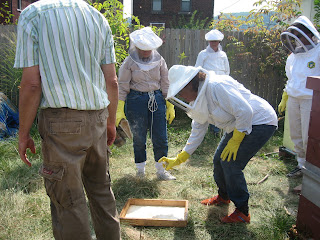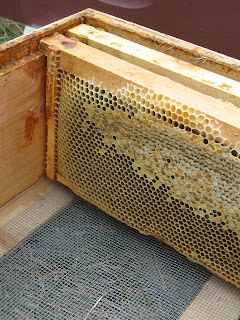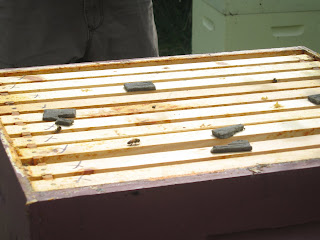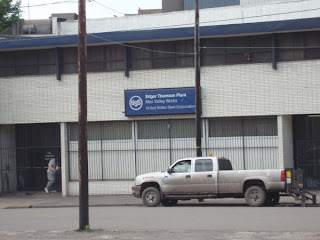Sunday, September 20, 2009
Fall Extraction, Part I
We were lucky enough to have a couple supers of fall honey on top of our one overwintered hive in Hazelwood. We feel very lucky as several of our beekeepers have noted a low fall flow this season. These gals have really been packing it in.
 In an urban area we are apt to use Bee Quick to clear the supers. Our students sprayed it onto the fume cover, and in the hot sun, the bees moved down into their hive bodies.
In an urban area we are apt to use Bee Quick to clear the supers. Our students sprayed it onto the fume cover, and in the hot sun, the bees moved down into their hive bodies.
 Then, the frames are easily moved without bees into a screened super to be transported to the kitchen for extraction.
Then, the frames are easily moved without bees into a screened super to be transported to the kitchen for extraction.

Fall Extraction, Part II
At the kitchen, Joe Z., demonstrated how to uncap with several different knives.
One of our students, Roberta, tests Joe's description of the knives.
In the second video, note that Joe points out that up to 10% of the honey can be in the capings, which is why you want to collect those and harvest that honey as well.
Steve had been kind enough to lend us his automatic extractor (though there are plans in the works for a bike powered extractor). The honey runs out from the uncapped centrifugal force as the frames spin.

The honey flows out of the extractor through a spout on the side near the bottom. The honey is strained, but not filtered.
One of our students, Roberta, tests Joe's description of the knives.
In the second video, note that Joe points out that up to 10% of the honey can be in the capings, which is why you want to collect those and harvest that honey as well.
Steve had been kind enough to lend us his automatic extractor (though there are plans in the works for a bike powered extractor). The honey runs out from the uncapped centrifugal force as the frames spin.
The honey flows out of the extractor through a spout on the side near the bottom. The honey is strained, but not filtered.
Back to Blogging
We've been very busy this summer and have fallen behind in our blogging duties. But, I hope that doesn't mean that you haven't been following our presence at all the events around town. Check out the events page on our website to see all the things we've been up to in the past months. We just had our ninth class which involved a honey extraction from our hives in Hazelwood (a blog entry to soon follow). Going forward, we hope to be more diligent in posting to the blog with pictures from our classes and events.
At this point in the season, we are checking on our hives to make sure they are healthy heading into winter. To do this, we've reduced their entrances and installed mouse guards.
 We've also started feeding sugar water in hive top feeders to help build up stores for the winter. Many beekeepers have had a very light fall honey flow. Additionally, we've treated for mites throughout the season with powdered sugar and apiguard. The frames are marked with an X to ensure that we do not harvest honey stored during the treatment.
We've also started feeding sugar water in hive top feeders to help build up stores for the winter. Many beekeepers have had a very light fall honey flow. Additionally, we've treated for mites throughout the season with powdered sugar and apiguard. The frames are marked with an X to ensure that we do not harvest honey stored during the treatment.
 To help accomplish these tasks, several of our class members have volunteered as stewards to watch the hives as the move into winter.
To help accomplish these tasks, several of our class members have volunteered as stewards to watch the hives as the move into winter.
At this point in the season, we are checking on our hives to make sure they are healthy heading into winter. To do this, we've reduced their entrances and installed mouse guards.
Sunday, May 31, 2009
Mt. Washington Installation
Robert and Alex carry in the first hive.
Two hives - a room with a view.
When letting the bees out, we put some grass in front of the hive to disorient the bees so they know to reorient themselves to their new home.
We added an extra hive body on the smaller hive. We sprayed the upper frames with sugar water to attract the bees to the upper box.
Wednesday, May 27, 2009
Hives to Braddock!

Jennifer and Robert returned the Braddock feral bees that we removed from a derelict building back in April and had requeened, back to their hometown last Friday May 22. We transported them in 5 frame nuc boxes then transferred them to 10 frame hive bodies in the back courtyard of the former St. Michael's convent on Braddock Avenue. The site was overgrown with Japanese knotweed which we made short work of.

The bees seem happy back in the shadow of the Edgar Thompson works across the street.

We also brought another small requeened hive to join the overwintered colony in Hazelwood. The big hive is doing extremely well, so we took a couple frames of emerging brood from the established colony and used them to strengthen the new one. While we have been successfully suppressing the swarm instinct so far by "opening up the brood nest" by removing capped brood, as well as keeping the overhead honey stores broken up, the swarm season hasn't passed, so we continue to monitor the situation.

The bees are finding plenty of nectar and pollen in the river bottom and are packing it in. We added another super of mostly foundation that we dispersed amongst the drawn and filling frames. Taking a tip from a recent issue of American Bee Journal, we put empty medium frames in the middle position of the supers to make cut comb honey. Lastly we made sure to cull the drone brood from the bottom of the drone brood trapping frame we had installed undrawn 4 weeks ago.
Wednesday, May 20, 2009
Zoo Class Part I
Today we had wonderful sunny weather for our first official class for zoo staff, who have graciously welcomed honeybees into their beautiful workspace! We're looking forward to more of these education opportunities at the Zoo! Above, Meredith talks through basic hive etiquette before the group goes into the hive.
Douglas Jones, Assistant Curator of Horticulture & Grounds, gets geared up for his trip into the hive.
Jennie talks to the group about basic bee biology and castes.
Zoo Staff Class Part II
Robert teaches the group about how to find eggs and larva on a frame. Robert installed some experimental frames in the zoo hives-including a wire frame and plastic foundation frame-to compare first hand how the bees within the same hive react to the different equipment.
Susan, who tends the roof garden holds a frame of brood, after inspecting for eggs.
Polar bear, who lives below the green roof, looks up hoping for lunch.
Zoo Staff Class Part III
The hive on the hill is doing quite well also. Although, given it was such a sunny and warm day, the bees were warm-you can see above the bees are hanging outside the entrance fanning the hive.
Thursday, May 14, 2009
Swarm Management, Hazelwood
A couple weeks ago, we inspected the hive at Hazelwood.The colony is building up fast--they seem to like it there! When we inspected, the drone/mite trap frame was capped so we removed it and replaced it with a medium frame with foundation (you can see the pictures of it here). There were other indications that the hive was preparing to swarm: there were a couple queen cups with egg and larva and the super was full of brood. To address the possibility of a swarm, we added a super of mixed empty comb and foundation frames both above and below the super with brood (compare the pictures below). Additionally, because the lower hive body had empty frames and was less active than the upper hive body, we reversed the hive bodies and removed 3 frames of brood, which we contributed to the nucs that we are establishing. We checked back in a week and found the queen—the tactics seemed to have worked. You can compare pictures of before (in the Pop City article) and after (when we checked back on the hive a week later).
Wednesday, May 13, 2009
Demonstration Apiary Installation: Pittsburgh Zoo
Demonstration Apiary: Pittsburgh Zoo II
A Nucleus Checkup
Sunday, May 10, 2009
Hazelwood Neighbors Class
Wednesday, May 6, 2009
Swarm Management and Impromptu Class at Hazelwood: Part I
Swarm Management and Impromptu Class at Hazelwood: Part II
Subscribe to:
Comments (Atom)
